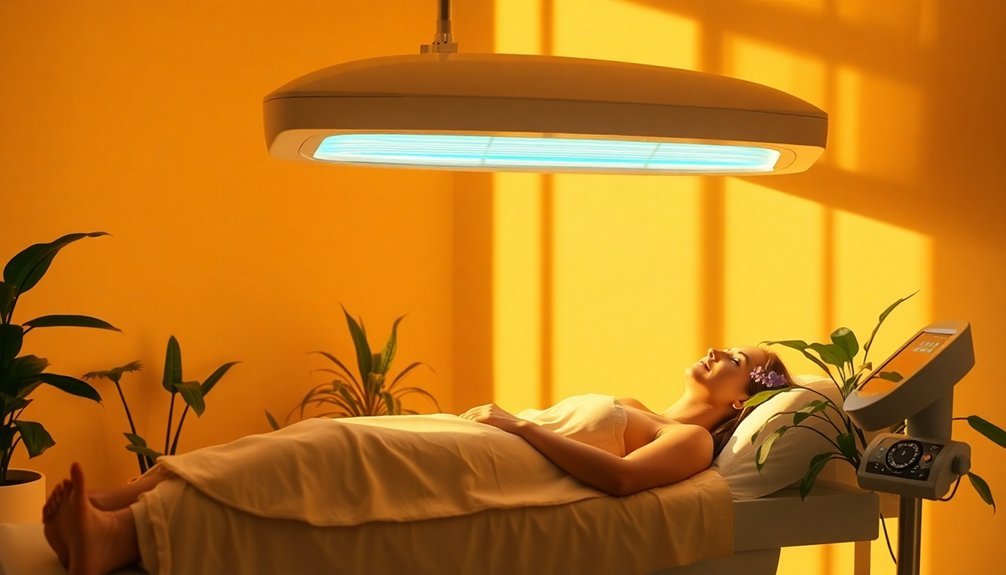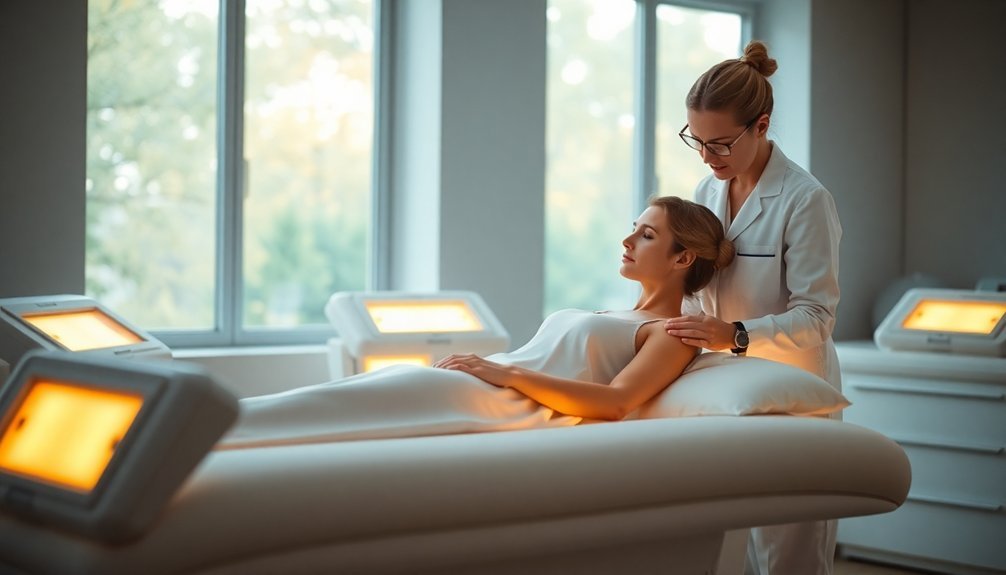If you're exploring phototherapy treatments for autoimmune diseases, the top three to evaluate are Broad Band UVB Therapy, Narrow Band UVB Therapy, and PUVA Treatment. Broad Band UVB effectively targets skin cell DNA, while Narrow Band UVB offers a specific wavelength that boosts your immune response. PUVA combines psoralens with UVA radiation, enhancing its benefits for various skin conditions. Each treatment requires consistency and poses potential side effects, so it's important to consult your healthcare provider. Want to discover how each option might work for you? Keep going to uncover more insights about these therapies.
Broad Band UVB Therapy

Broad Band UVB Therapy is an effective treatment option for autoimmune diseases affecting the skin. This therapy utilizes UV light, specifically type B radiation, which absorbs into the epidermis and superficial dermal layers. By targeting skin cell DNA, it slows their rapid growth and division, reducing inflammation and modulating the immune response, making it particularly beneficial for autoimmune conditions.
You'll typically need about 3-5 treatments each week, and your schedule can be adjusted based on how well you're responding. Keep in mind that consistency matters; getting fewer than three sessions weekly mightn't deliver the desired results. Phototherapy session length varies depending on your specific skin type and responsiveness to the treatment.
Safety is key, as overdosing can cause erythema, so your doctor will gradually increase your dosage to an effective level.
While it's effective, Broad Band UVB Therapy can also have side effects. Your skin may turn red, itchy, or dry, and there's a risk of premature aging or temporary worsening of skin conditions.
Always discuss your history and conditions with your healthcare provider, especially if you're prone to cold sores or have liver disease. This therapy offers significant benefits while requiring careful management to minimize risks.
Narrow Band UVB Therapy
Utilizing Narrow Band UVB Therapy can offer a targeted approach to treating various autoimmune skin conditions. This therapy emits light at a specific wavelength—311-312 nm—effectively targeting affected areas of your skin.
Studies show it can increase the numbers and suppressive functions of peripheral T-regulatory cells, which help manage your immune response. Additionally, UVB light can induce skin-derived tolerogenic dendritic cells, helping to alleviate systemic autoimmunity and mitigate conditions like autoimmune encephalomyelitis. Research indicates that insufficient vitamin D levels are identified as independent risk factors for MS, linking to immune modulation related to the therapy.
Clinically, Narrow Band UVB is effective for treating psoriasis, showing higher clearance rates than broadband UVB. It's also beneficial as an adjunctive treatment for moderate to severe atopic eczema.
The procedure is straightforward; you'll stand in a cabinet designed for this therapy, with sessions lasting from a few seconds to several minutes. Most patients undergo treatment two to five times a week while ensuring adequate vitamin D levels.
Though it's generally safe with minimized risks of skin burning, be aware of potential short-term side effects like dry skin or blistering.
Long-term risks can include skin aging and, in rare cases, skin cancer, making it essential to follow guidelines closely for safe use.
PUVA Treatment

PUVA treatment combines the use of psoralens and UVA radiation to effectively manage various autoimmune skin diseases. It induces immunosuppression by altering cytokines and promoting lymphocyte apoptosis, which can provide relief for conditions like psoriasis and vitiligo.
Here are some important aspects you should know:
- Conditions Treated: PUVA is beneficial for psoriasis, vitiligo, lichen planus, and cutaneous T-cell lymphoma. It's especially effective for widespread psoriasis and facial vitiligo.
- Mechanism of Action: Psoralens intercalate between DNA base pairs and form crosslinks upon UVA exposure, leading to antiproliferative effects and stimulation of melanocyte activity. Additionally, the use of methoxsalen capsules prior to treatment enhances the overall effectiveness.
- Risks and Precautions: While short-term side effects like erythema and nausea are common, long-term risks can include skin cancer and cataracts. You need to wear UVA-opaque sunglasses, use sunscreen, and have yearly dermatological check-ups.
Understanding these key points can help you navigate the benefits and risks of PUVA treatment.
Always consult with your healthcare provider to determine if this treatment aligns with your individual health needs.
Frequently Asked Questions
Can Phototherapy Be Combined With Other Treatments for Autoimmune Diseases?
Yes, you can combine phototherapy with other treatments for autoimmune diseases. For instance, using narrowband UV-B with corticosteroids enhances effectiveness, while immunosuppressive medications may work alongside phototherapy to improve overall treatment outcomes.
How Long Does It Typically Take to See Results From Phototherapy?
You'll usually notice results from phototherapy in 1-3 months, but it can take up to 6 months for full effectiveness. Consistency in treatment is key, so stick to your recommended schedule for ideal outcomes.
Are There Specific Skin Types That Respond Better to Phototherapy?
You might be surprised to learn that phototherapy works effectively across all skin types. Research shows there's no significant difference in response between lighter and darker skin, making treatment options more accessible and beneficial for everyone.
Is Phototherapy Safe for Children With Autoimmune Skin Conditions?
Yes, phototherapy's generally safe for children with autoimmune skin conditions when properly administered. You'll need a trained professional to monitor treatment closely and tailor it to your child's specific needs for best results and minimal risks.
What Are the Long-Term Effects of Phototherapy on Skin Health?
Phototherapy can lead to skin erythema, xerosis, and potential long-term effects like photoaging and actinic keratosis, especially after extensive treatments. Regular skin checks and protective measures are essential to maintain your skin's health.
In Summary
In summary, if you or someone you know suffers from an autoimmune disease, considering phototherapy can be a game changer. Broad Band UVB, Narrow Band UVB, and PUVA treatments each offer unique benefits that can help manage symptoms effectively. Consulting with a healthcare professional to find the best fit for your specific condition is essential. Embracing these therapies might just lead to a significant improvement in quality of life for autoimmune disease patients.





Leave a Reply